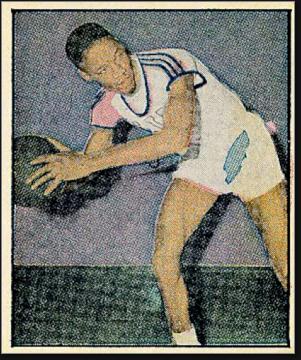
Sport: Basketball
Born: December 16, 1928
Died: August 4, 2011
Town: Englewood, New Jersey
Sherman White was born December 16, 1928 in Philadelphia and grew up in Englewood, NJ. Tall and athletic, Sherman became a dominant basketball player at Dwight Morrow High School under coach Tom Morgan. As a 6’8″ senior in 1946–47, Sherman led the school to an undefeated season and set a state record with 49 points in a game. Several colleges scouted him, but most were scared away by his poor grades. Coach Morgan, a Villanova grad, steered him toward his alma mater, but when Sherman arrived on campus he found he was the lone African-American in an all-white school. He dropped out and moved back home.
Clair Bee, the legendary coach at Long Island University, invited Sherman to scrimmage with his team. LIU had one of the nation’s top teams, yet Sherman dominated the scrimmage. He accepted a scholarship and joined the Blackbirds varsity for the 1948–49 season. The following year, he blossomed into one of the best big men in the country. He scored 20 points regularly—including a school-record 63 in one game—and won the Hagerty Award as the NY-Metro region’s top player. He was also a second-team All-American.
During that great junior season, Sherman noticed that three teammates seemed to be throwing horrendous passes and missing shots they normally made. They were shaving points. By the end of the year, they had co-opted Sherman. Their pitch was that they weren’t losing games, just winning by fewer points than expected—and getting paid to do so. With his family struggling to make ends meet, it was hard to say no to $1,000 a game.
During the 1950–51 season, rumors swirled around LIU and other New York schools—including City College and NYU—that key players were getting paid off by gamblers. The police launched an investigation focusing on professional gambler Salvatore Sollazzo. On February 19, Sherman was named The Sporting News College Player of the Year. One day later, Sherman was arrested. He was averaging over 27 points a game at the time, and was three or four games away from breaking the NCAA’s single-season scoring mark. LIU shut down its entire athletic program for the next six years.
Most of the players implicated in the point-shaving scandal were found guilty and given suspended sentences. As the superstar among the defendants, Sherman was made an example of by judge Saul Streit. He was sent to Riker’s Island and served 8 months and 24 days before being released. He was also banned from playing in the NBA. Sollazzo served 12 years.
Ironically, Sherman would have had a major payday at the end of the 1951 season. The Knicks had targeted him as their territorial pick and would have signed him to a $15,000 annual contract. The Knicks reached the NBA Finals that spring and fell to the Lakers 4 games to 3. They lost to the Lakers again in the 1952 and 1953 finals. One wonders how history might have changed had Sherman been in the pivot for New York against large-but-lumbering George Mikan.
Sherman did play professionally during the 1950s, in the highly competitive Eastern Professional Basketball League, mostly with the Hazelton Hawks and Baltimore Bullets. He was good for 20 to 30 points most nights and often led his team in assists. In 1955, he was named EPBL Most Valuable Player. Sherman worked for many years as a salesman, and also coached youth basketball in Essex County. Sherman passed away in 2011 at age 82 from heart failure.